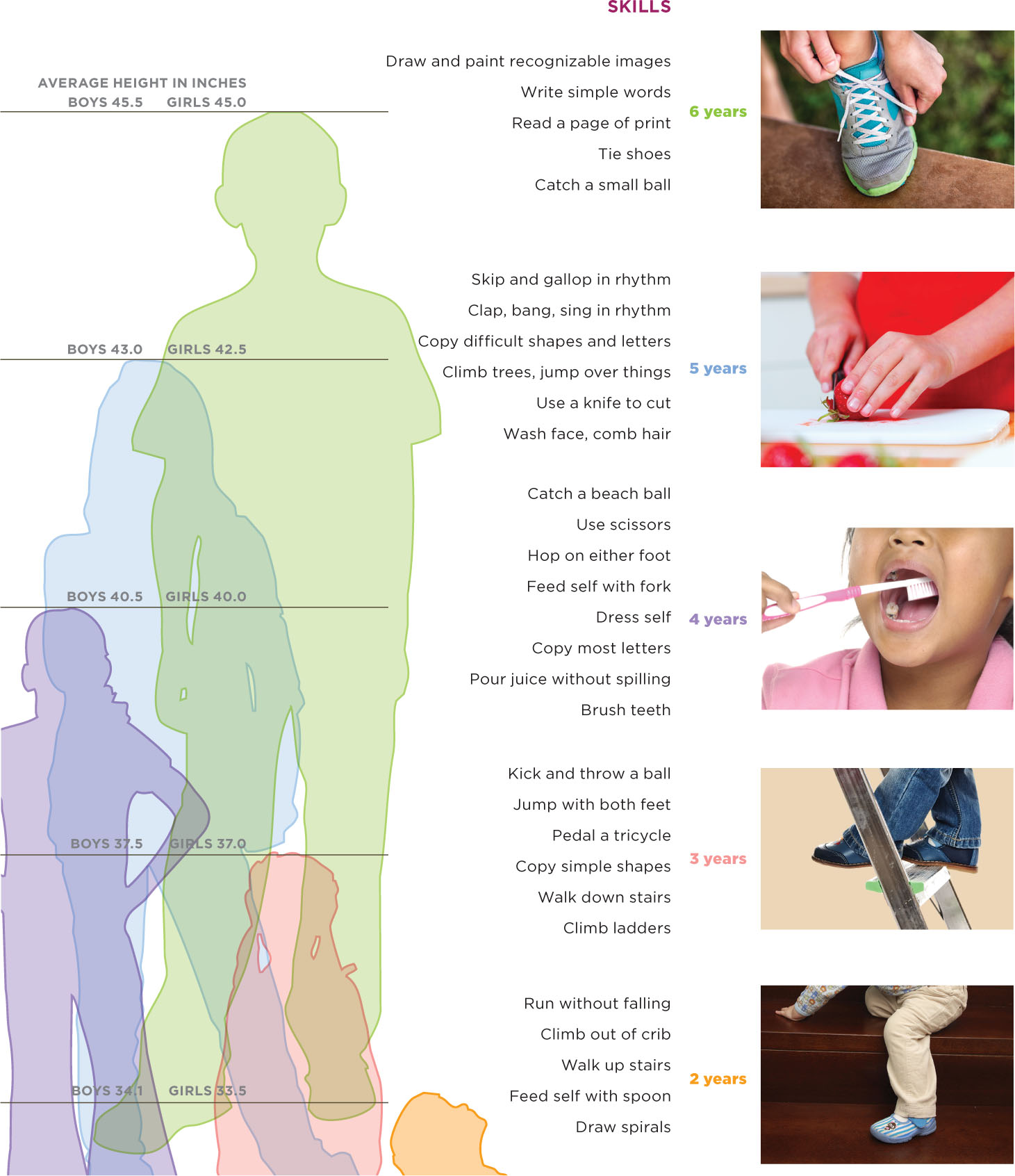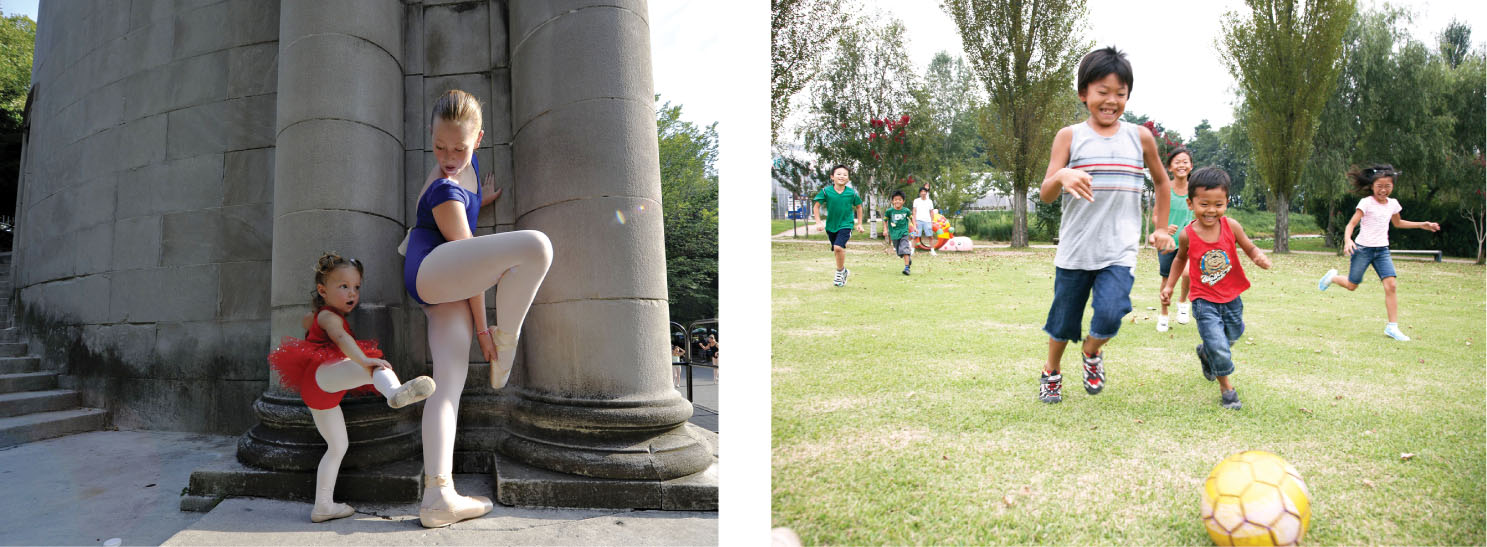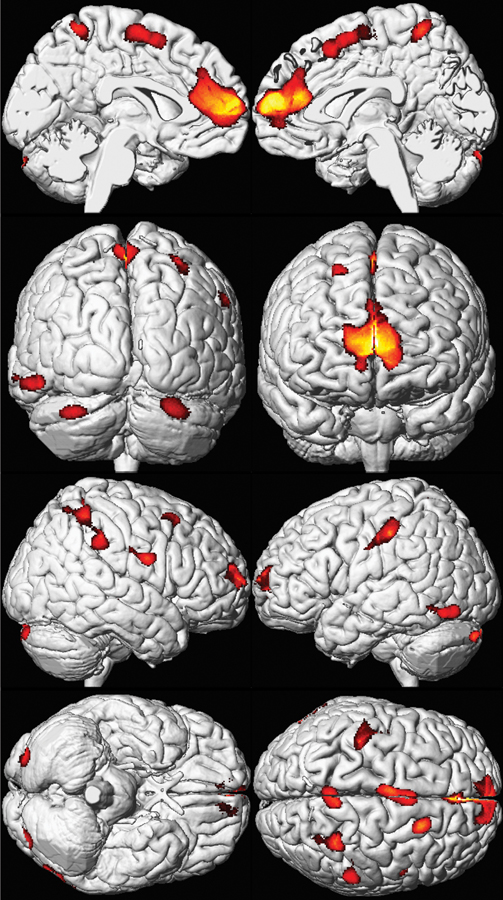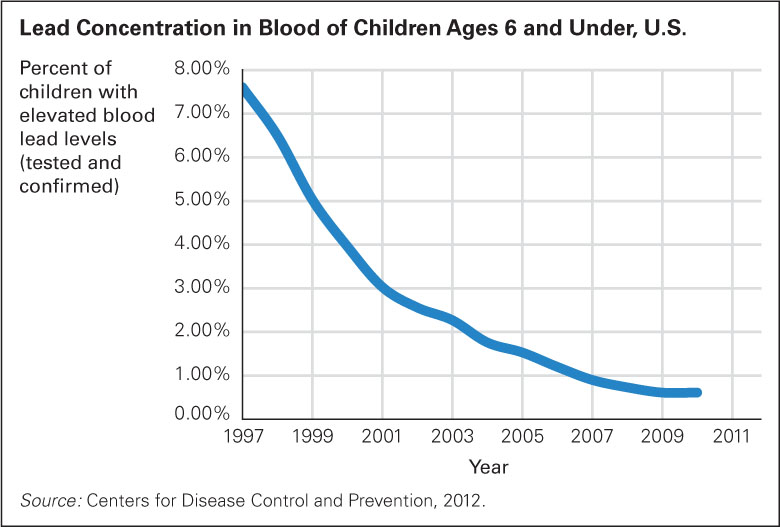 Improving Motor Skills
Improving Motor Skills
Maturation of the prefrontal cortex allows impulse control, whereas myelination of the corpus callosum and lateralization of the brain permit better physical coordination. No wonder children move with greater speed, agility, and grace as they age. (See Visualizing Development, p. 228.)
Mastery of gross and fine motor skills results not only from maturation but also from extensive, active play. A study in Brazil, Kenya, and the United States tracked how young children spend their time. Cultural variations and differences based on socioeconomic status (SES) emerged. For example, middle-
| Motor Skills at Ages 2– |
||
|---|---|---|
| Approximate Age | Skill or Achievement | |
| 2 years | Run for pleasure without falling (but bumping into things)Climb chairs, tables, beds, out of cribsWalk up stairsFeed self with spoonDraw lines, spirals | |
| 3 years | Kick and throw a ballJump with both feet off the floorPedal a tricycleCopy simple shapes (e.g., circle, rectangle)Walk down stairsClimb ladders | |
| 4 years | Catch a ball (not too small or thrown too fast)Use scissors to cutHop on either footFeed self with forkDress self (no tiny buttons, no ties)Copy most lettersPour juice without spillingBrush teeth | |
| 5 years | Skip and gallop in rhythmClap, bang, sing in rhythmCopy difficult shapes and letters (e.g., diamond shape, letter S)Climb trees, jump over thingsUse knife to cutTie a bowThrow a ballWash face, comb hair | |
| 6 years | Draw and paint with preferred handWrite simple wordsScan a page of print, moving the eyes systematically in theappropriate directionRide a bicycleDo a cartwheelTie shoesCatch a ball | |
| *Context and culture are crucial for acquisition of all these skills. For example, many 6- |
||
Gross Motor Skills
Gross motor skills improve dramatically. When playing, many 2-
Specific Skills
Many North American 5-
Adults need to make sure children have a safe space, time, appropriate equipment, and playmates. Children learn best from peers who demonstrate whatever the child is ready to try, from catching a ball to climbing a tree. Of course, culture and locale influence particulars: Some small children learn to ski, others to sail.
VISUALIZING DEVELOPMENT
Developing Motor Skills
Every child can do more with each passing year. These examples detail what one child might be expected to accomplish from ages 2 to 6. But each child is unique, and much depends on culture, practice, and maturity.

PHOTO: AARON BELFORD/SHUTTERSTOCK
PHOTO: RAMONA HEIM/SHUTTERSTOCK
PHOTO: NALUWAN/SHUTTERSTOCK
PHOTO: NEJRON PHOTO/SHUTTERSTOCK
PHOTO: ARTEM EFIMOV/SHUTTERSTOCK

SEIYA KAWAMOTO/GETTY IMAGES
Recent urbanization concerns many developmentalists. A century ago children with varied skill levels played together in empty lots or fields without adult supervision, but now more than half the world’s children live in cities. Many of these are “megacities … overwhelmed with burgeoning slums and environmental problems” (Ash et al., 2008, p. 739).
Crowded, violent streets not only impede development of gross motor skills but also add to the natural fears of the immature amygdala, responding to the learned fears of adults. Gone are the days when parents told their children to go out and play, to return when hunger, rain, or nightfall brought them home. Now many parents fear strangers and traffic, keeping their 3-
Environmental Hazards
Observable dangers are not the only problem. Children who breathe heavily polluted air tend to be impaired in brain development. Is this correlation or causation? Such children often live in low-
Scientists have grappled with this question and answered yes: Environmental substances cause problems in young children at every SES level, but especially those in lower-
As you already know, the dynamic systems approach to development means that every impairment has many causes, both in the immediate context and in the impact of past genetic and environmental factors. Nonetheless, a recent study conducted in British Columbia, where universal public health care and detailed birth records allow solid research, showed that air pollution from traffic and industry early in life was one cause, not just a correlate, of asthma (Clark et al., 2010).
This study began with all births in 1999 and 2000 in southwest British Columbia (which includes a major city, Vancouver). For three years, 37,401 children were studied, 3,482 of whom were diagnosed with asthma by age 3. Each of those 3,482 was matched on SES, gender, and so on with five other children from the same group.
Exposure to air pollution, (including carbon monoxide, nitric oxide, nitrogen dioxide, particulate matter, ozone, sulfur dioxide, black carbon, wood smoke, car exhausts, and smoke from parents’ cigarettes) was carefully measured.
One finding was that parents could not always protect their children, partly because they did not always know when substances caused poor health. For example, although carbon monoxide emissions are not apparent, when compared to their five matched peers who did not have asthma, those children who were diagnosed with asthma were more likely to live near major highways, where carbon monoxide is more prevalent. Conversely, because wood smoke is easy to see and smell, some parents tried to avoid it, but burning wood did not increase asthma.
Respiratory problems are not the only early-
The administrator of environmental public health for the state of Oregon said, “We simply do not know—
Lead, however, has been thoroughly researched. The history of lead exposure in the United States illustrates the long path from science to practice, as the following A View from Science illustrates.
A VIEW FROM SCIENCE
Eliminating Lead

Lead was targeted as a poison a century ago (Hamilton, 1914). The symptoms of plumbism, as lead poisoning is called, were obvious—
The lead industry defended the heavy metal as an additive, arguing that low levels were harmless, and blamed parents for letting their children eat flaking chips of lead paint (which tastes sweet). Further, since children with high levels of lead in their blood were often from low-
Consequently, lead remained a major ingredient in paint (it speeds drying) and in gasoline (it raises octane) for most of the twentieth century. The fact that babies in lead-
Finally, chemical analysis of blood and teeth, with careful longitudinal and replicated research, proved that lead was indeed a poison for all children (Needleman et al., 1990; Needleman & Gatsonis, 1990). The United States banned the use of lead in paint (in 1978) and automobile fuel (in 1996). The blood level that caused plumbism was set at 40 micrograms per deciliter, then 20, then 10 (and recently danger is thought to begin at 5 micrograms), with no level proven to be risk-
Regulation has made a difference: The percentage of U.S. 1-
Parents are beginning to do their part: They are increasing their children’s calcium intake, wiping window ledges clean, testing drinking water, avoiding lead-

FIGURE 8.5
Dramatic Improvement in a Decade Once researchers established the perils of high lead levels in children’s blood, the percentage of children suffering from plumbism fell by more than 300 percent. Levels are higher in states that once had heavy manufacturing and lower in mountain and Pacific states.In some states (e.g., Colorado and Wyoming), average lead levels for young children are close to zero. In other states that once had extensive lead-
Remember from Chapter 1 that scientists sometimes use data collected for other reasons to draw new conclusions. This is the case with lead. About 15 years after the sharp decline in blood lead levels in preschool children, the rate of violent crime committed by teenagers and young adults fell sharply.
As some nations reduced lead in the environment sooner or later than others, year-
A scientist comparing these two trends concluded that some teenagers commit impulsive, violent crimes because their brains were poisoned by lead when they were preschoolers. The correlation is found not only in the United States but also in every nation that has reliable data on lead and crime—
Fine Motor Skills
Fine motor skills are harder to master than gross motor skills. Whistling, winking, and especially writing are difficult actions. Pouring juice into a glass, cutting food with a knife and fork, and achieving anything more artful than a scribble with a pencil all require a level of muscular control, patience, and judgment that is beyond most 2-
Many fine motor skills involve two hands and thus both sides of the brain: The fork stabs the meat while the knife cuts it; one hand steadies the paper while the other writes; tying shoes, buttoning shirts, cutting paper, and zipping zippers require both hands.
Especially for Immigrant Parents You and your family eat with chopsticks at home, but you want your children to feel comfortable in Western culture. Should you change your family’s eating customs?
Response for Immigrant Parents: Children develop the motor skills that they see and practice. They will soon learn to use forks, spoons, and knives. Do not abandon chopsticks completely, because young children can learn several ways of doing things, and the ability to eat with chopsticks is a social asset.

NILS HENDRIK MUELLER/GETTY IMAGES
Limited myelination of the corpus callosum may be the underlying reason that shoelaces get knotted, paper gets ripped, and zippers get stuck. Short, stubby fingers add to the problem. As with gross motor skills, practice and maturation are key; using glue, markers, and scraps of cloth are part of the preschool curriculum. Puzzles—
Traditional academic learning depends on fine motor skills and body control. Writing requires finger control, reading a line of print requires eye control, sitting for hours at a desk requires bladder control, and so on. These are beyond most young children, so even the brightest 3-
Slow maturation is one reason some 6-
Fine motor skills—
Artistic Expression

Young children are imaginative, creative, and not yet self-
All forms of artistic expression blossom during early childhood; 2-
For example, when drawing a person, 2-
Cultural and cohort differences are apparent. For the most part, Chinese culture incorporates the idea that drawing benefits from instruction, so young children are guided in how best to draw a person, a house, and—
SUMMING UP
Maturation of the brain leads to better hand and body control. Gross motor skills advance every year as long as young children have space to play, older children to emulate, and freedom from environmental toxins. Sadly, pollution, crowding, and fear of strangers reduce the opportunities many contemporary children have to develop gross motor skills, and may affect their overall learning as well.
Young children also develop their fine motor skills, preparing them for formal education. They love to dance, draw, and build, all of which helps in the gradual mastery of finger movements, which will in turn be essential when they start to write.